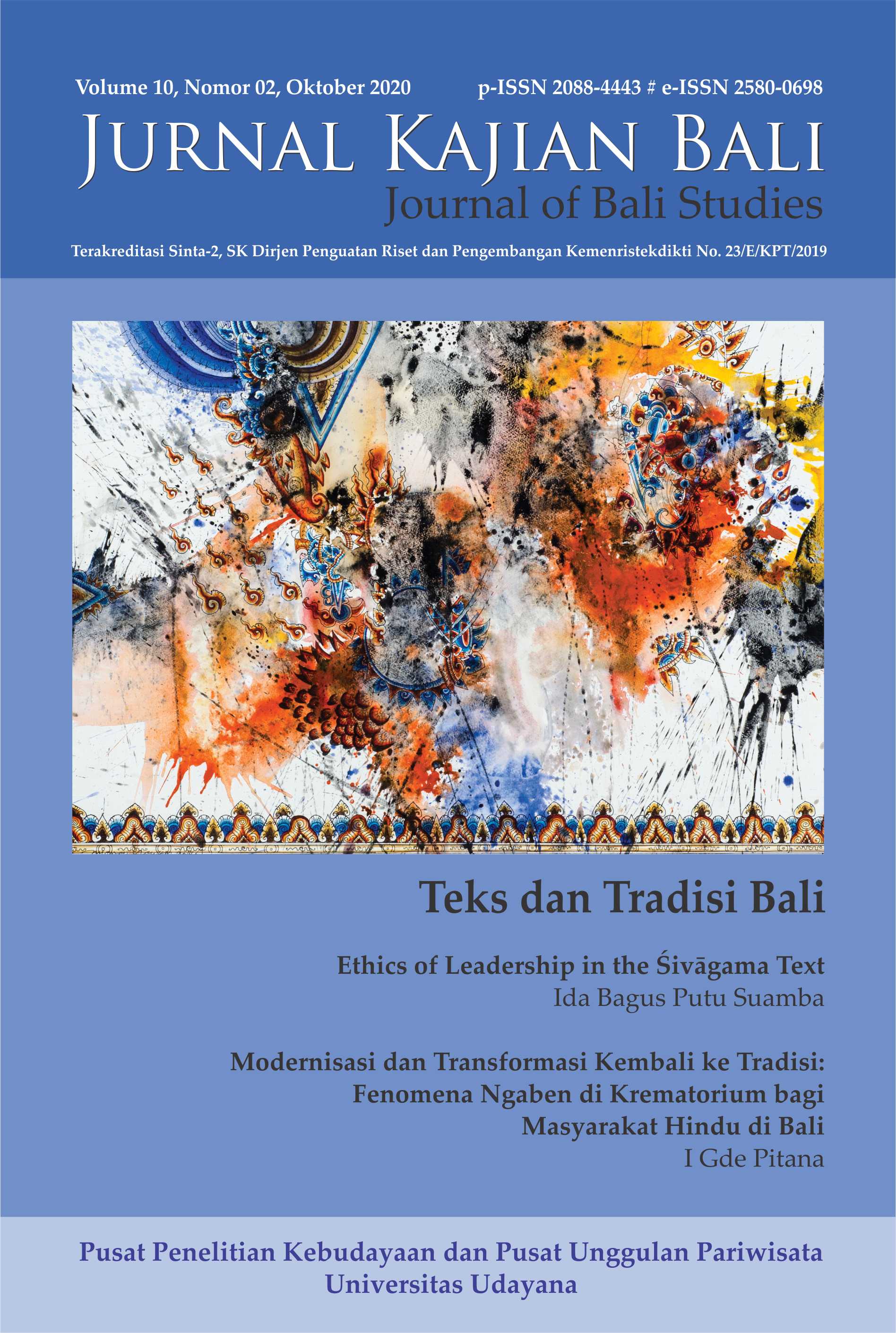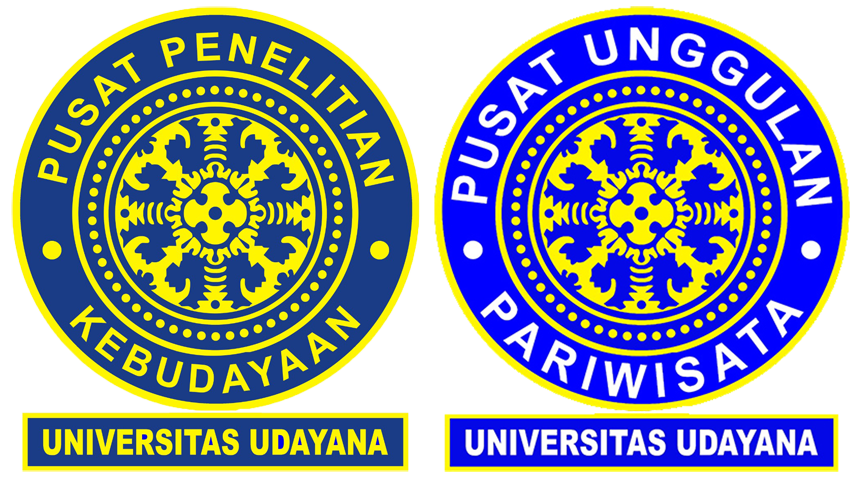Modernisasi dan Transformasi Kembali ke Tradisi: Fenomena Ngaben di Krematorium bagi Masyarakat Hindu di Bali
Abstract
Conducting cremation ceremony (ngaben) in crematorium among Balinese Hindus is relatively a new phenomenon, pioneered by Maha Gotra Pasek Sanak Sapta Rsi, the biggest maxima-clan in Bali. This maxima-clan constructed a crematorium called Santhayana in 2008. The number of cremation ceremony conducted in Crematorium Santhayana increases over time, mainly due to the practical values and efficiency, compared to conducting the ceremony conventionally in one’s own village. The more affordable cost and the less intensive communication with the village of origin are yet additional reasons, especially for those residing outside Bali. By employing participant-observation and in-depth interviews in data collection, analysed qualitative-interpretively, this research confirmed Giddens’ Structuration theory, that as duality, structure is both constraining and enabling the actors. On the other hand, actors’ patterned activities will develop new structure. However, it is interesting in the case of cremation in crematorium Santhayana, that the transformation toward modernity is by making use of traditional reference, i.e. old lontar, named Yama Purana Tatwa.
Downloads
References
Arjawa, Suka GPB. (2016). Ngaben di Krematorium, Fenomena Perubahan Sosial di Bali. Tabanan: Pustaka Ekspresi
Aryadharma, NK Surpi. 2011. Membedah Kasus Konversi Agama di Bali. Surabaya: Penerbit Paramita.
Bali Express, 17 September 2018. “Ngaben Puput dan Patut Jadi Solusi Orang Bali Takut Mati di Bali”. Editor :I Putu Suyatra. Bali Express, Denpasar
Bungin, Burhan. (2011). Penelitian Kualitatif. Edisi Kedua. Jakarta: Kencana Prenada Media Group.
Claidière, N., Scott-Phillips, T. C., & Sperber, D. (2014). How Darwinian is cultural evolution? Philosophical Transactions of the Royal Society, B: Biological Sciences, 369(1642)
Claidière, N., Kirby, S., & Sperber, D. (2012). “Effect of psychological bias separates culturalfrom biological evolution”. Proceedings of the National Academy of Sciences, 109(51),E3526.
Giddens, Anthony. (1984). The Constitution of Society. Outline of the Theory of Structuration. Cambridge: Polity Press.
Giddens, Anthony. (1991). Modernity and Self-Identity: Self and Societyin the Late Modern Age. Stanford: Stanford University Press.
Henrich, J. (2001). “Cultural transmission and the diffusion of innovations: Adoption dynamics indicate that biased cultural transmission is the predominate force in behavioral change”. American Anthropologist, 992–1013.
Idrus, Muhammad. (2007). Metode Penelitian Ilmu-Ilmu Sosial. Yogyakarta: UII Press.
Kronfeldner, M. (2007). “Is cultural evolution Lamarckian?” Biology and Philosophy, 22(4), 493–512.
Johnson, Kirk. (2004). Globalisation and Culture in Contemporary India: Tradition vs Modernity. Dalam Lan-Hung Nora Chiang et al. The Challenges of Globalization. Oxford, UK: University Press of America. H. 119-130.
Jones, RIP. (2009). Pengantar Teori-Teori Sosial, dari Teori Fungsionalisme hingga Post-Modernisme. Jakarta: Buku Obor.
Kebayantini, Ni Nyoman. (2013). Komodifikasi Upacara ngaben di Bali.Jurnal Kajian Bali (Journal of Bali Studies). Volume 08, Nomor 01, April 2018. Hlm. 32-52.
Martono, Nanang. (2011). Sosiologi Perubahan Sosial, Perspektif Klasik, Modern, Posmodern, dan Poskolonial. Jakarta: Rajawali Press.
MGPSSR Pusat.(2001). Sawa Prakerti:Pedoman Tataning Bebantenan Pitra Yadnya Ring Warga Pasek. Denpasar: MGPSSR.
Moldagaliyev, B., T. Gabitov, A. Kulsariyeva, and E. Baydarov.(2014). “Transformation of Cultural Policy in the Context Dichotomy ‘East – West.’” Procedia - Social and Behavioral Sciences 140: 700–703. https://doi.org/10.1016/j.sbspro.2014.04.498.
Parisada Hindu Dharma Indonesia Pusat.(1990). Himpunan Kesatuan Tafsir terhadap Aspek-Aspek Agama Hindu, I-IX. Jakarta: Parisada Hindu Dharma Indonesia Pusat.
Picard, Michel. (2017). From Agama Hindu Bali to Agama Hindu: Two styles of argumentation. Jurnal Kajian Bali.Volume 07, Nomor 02, Oktober 2017. Hlm. 199–228
Pitana, I Gde.(2018). Mudahnya Beragama Hindu. Materi disajikan dalam Dharma Wacana di Pura Dharma Siddhi, Tangerang.
Pitana, I Gde.(2019).”Cremation Ceremony, Returning Borrowed Elements to Nature.” ICH Courier, Vol. 38: 20-21
Pradnya, I Made Adi Surya. (2020). “Ephemeralization” dalam Pelaksanaan Upacara Perkawinan Adat Bali. Jurnal Kajian Bali (Journal of Bali Studies). Volume 10, Nomor 01, April 2020. Hlm. 261-282
Ritzer, George. (2003). Teori Sosial Postmodern. Terjemahan dari The Postmodern Social Theory. Penerjemah: Muhamad Taufik. Yogyakarta: Kreasi Wacana.
Saridewi, Putu Wiwik Rismayanti. (2017). Persepsi Umat Hindu Terhadap Keberdaan Krematorium Santayana Denpasar Bali. Jurnal Penelitian Agama Hindu , Vol. 1 No 2, Oktober 2017.
Soetama, Gde Aryanta. (2011). Jangan Mati di Bali. Jakarta: PT Gramedia.
Suara Pasek. (2008). Krematorium Warga Pasek Siap Beroperasi. Denpasar: Suara Pasek Edisi No. 4.
Suara Pasek. (2009). “Krematorium Digunakan Masyarakat”. Denpasar: Suara Pasek Edisi No. 5.
Sudarsana, I Nyoman.(2012). “Upacarangaben Kremasi di Krematorium Santhayana Denpasar Utara, Kajian Nilai Pendidikan pada Perubahan Sosial Keagamaan”. Thesis S2, Program Pascasarjana, Institut Hindu Dharma Negeri Denpasar.
Tennie, C., Call, J., & Tomasello, M. (2009). “Ratcheting up the ratchet: On the evolution ofcumulative culture. Philosophical Transactions of the Royal Society, Biological Sciences, 364(1528), 2405–2415.
Wijaya, Nyoman. (2007). Serat Salib dalam Lintas Bali: Sejarah Konversi Agama di Bali, 1931-2001. Denpasar: TSP Book.
Wijayananda, IMP Jaya. (2018). Dudonan Pitra Yadnya. Materi disampaikan dalam Kursus Pemangku Lanjutan, MGPSSR Pusat, Denpasar.
Wright,Thomas. (2015). Water, Tourism, and Social Change: A Discussion of Environmental Perceptions in Bali. Jurnal Kajian Bali, Volume 05, Nomor 01, April 2015, hlm. 1 – 22.

This work is licensed under a Creative Commons Attribution 4.0 International License.



















